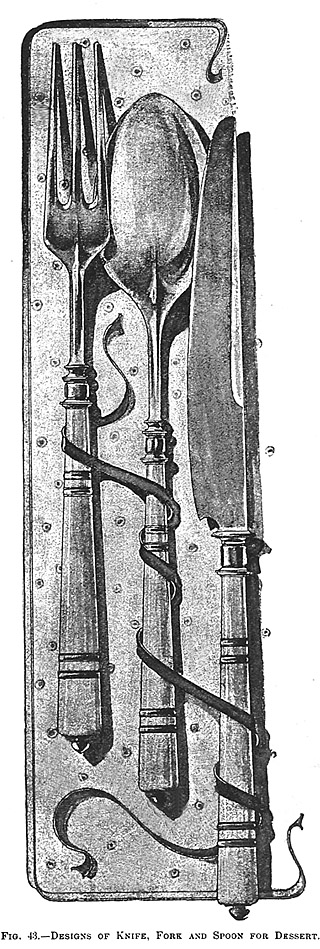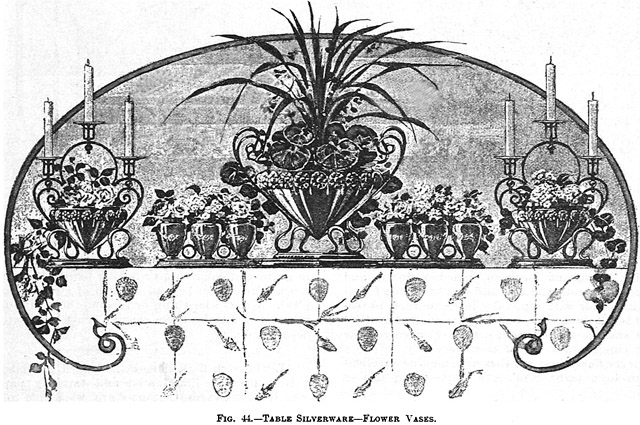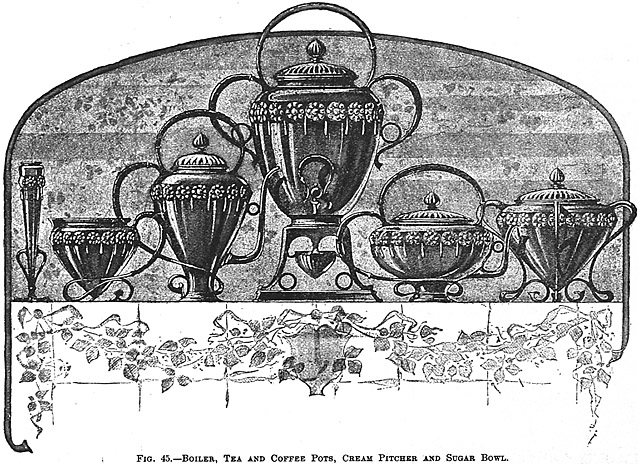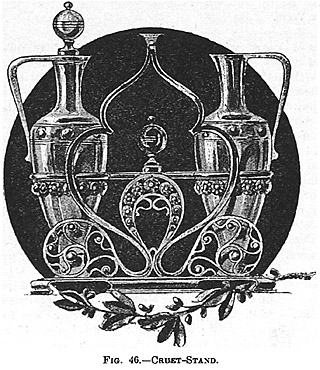posted 03-15-2017 12:40 PM



THE DECORATOR AND FURNISHER.
1891THE MODERN HOUSE
ITS DECORATION AND FURNITURE
VIII.
THE DINING-ROOM-SILVERWARE.
By A. Sandier.
Translated from the Revue Illustee.
Just as in the bed chamber the principal piece of furniture is the bed, so in the dining-room it is the table. We should not be surprised, therefore, if a great portion of our time be devoted to what may be called the "dress of the table," that is to the utensils in which our meals are served, to the silverware which, whether it be plentiful or not, richly or soberly decorated, sparkles on the white damask in the center of the glass and flowers, adding the brilliancy of its decoration to the cheerfulness of the feast. For this is a rule: a repast should always be cheerful. The least that we can do when entertaining our friends is to rejoice their eyes with surroundings all of which are able to contribute to their pleasure and, in their honor, to exhibit the best of our possessions, the precious vessels.
It is good manners for an intelligent woman to exhibit the table service to the guests with taste, with tact and with intelligence.
It is in these matters of refinement that each finds expression for his taste, delicacy and character. Theories in this connection are superfluous. Who would not feel that a table at which grave diplomats were to be seated could not receive the decorations which would find place there were it a party of young madcaps? A dinner party of intimate friends would exclude the imposing silverware of a formal dinner. The service of silver, or of silver gilt, employed by the newly married in the langorous tete-a-tete of the honeymoon should not be more pleasing, though of lighter form, than that of mature age when the family is numerous, and all the things have taken on a manner of amplitude and paternal gravity. The silverware in the dining-room is like the books in the study or the trinkets in the boudoir; by the titles of the volumes, and by the decorousness of the dress we divine the character of the owners, their preferences, their originality, if they have any, and the excellence of their taste.
Of old in the gorgeous world of lords and princes the passion for plate amounted almost to a frenzy, and we know of many repetitions of severe royal ordinances setting limits to the senseless prodigality committed in this direction. Until about the time of Henry II. the use of glass was hardly known, while porcelain and faience was entirely unknown. On the tables were only the goblets and cups, in gold and silver, large basins for holding the viands and fruit into which each diner dipped as he fancied, for forks did hot exist at that time, and they ate with their hands. This primitive method of proceeding lasted until about the close of the XVI century. When at this time the fork made its appearance on royal tables it was relieved, by a volley of ridicule. The makers of epigrams were astounded that one should prefer to carry this "little branched instrument" to his mouth rather than his fingers. The great king Louis XIV. was never able to thoroughly accustom himself to eating in this manner, and, saving at ceremonious dinners, as narrated by Saint Simon, he preferred to use his fingers. Up to that time the fork had only been employed in making roasts, etc. A collection of six forks, possessed by Charles V. in his splendid treasures, are cited as a rarity.
But in default of forks many other pieces of plate carved by the most celebrated artists figured on the tables of the luxurious. What was called "plate dishes," before the modern invention of silver and electroplating, was a necessary portion of all recent furniture. Only the common people of the XVII. and XVIII. centuries, did not eat from silver utensils. Naturally the beauty of the form and the delicacy of the execution varied according to the price which was paid for them. Benvenuto, Cellini, Ballin and Germain, who decked the tables of royalty and of princes with their admirable compositions were, naturally, not accessible to all the world. But as each piece as a rule was worked out separately by hand the designs were never hackneyed. In olden days there was not that uniformity in surroundings that today almost leads one to suppose that there is but one furniture dealer in the whole of Europe.
Unfortunately we are able to form only an imperfect idea of the richness and brilliancy of the plate of a table of previous centuries since the major portion of the beautiful works of that kind have been destroyed. King Louis XIV. has given us an example of shocking vandalism, for it was he who sent to the mint that marvelous vessel of gold and silver fashioned after the designs of Lebrun. He was pressed for money for his armies in need and so submitted to the sacrifice. It was to him like a sacrifice of his Own life, and it was made too late. What has become of the beautiful table service of the time of the Regency, the exquisite specimens of a perfect style; precious and delightful models which unite the accuracy and majesty of a grand reign with the delicate grace of a most sweet and chatoyant simplicity? What has been the fate of the six hundred thousand pounds of silverware in rugged style which was possessed by Mme. Pompadour, and of which she has given a detailed account in one of her letters? And of the enormous soup tureens of La Dubarry? The plates garlanded with leaves which she presented to her royal lover in the suppers at Marly, where they have gone? Where would we meet to day an entire service carved by silversmiths so noted as Cheret, Auguste and Francois Joubert, as was done for Marie Antoinette? Where are the dishes, the candlesticks, the cruet stands which ornamented the dining-room of Trianou? All is lost, destroyed, and all that are left are a few stray specimens of these chefs-d'oeuvres in collections.
Does this mean that in our day no noteworthy silverware is made? Certainly not. We still have, thank Heaven, able artists who bring to bear all the resources of the precious metals, varying their color, using the effects of forging, combining the simplicity of repousse with enamel and niello, in short exercising the most refined taste throughout in the marking of plates, tureens and knives. But their work is not destined for those not enjoying the privileges of a fortune.
To-day the problem of manufacture is to produce something for the masses, for a public which increases without cessation. The hand of man is too slow to suffice for treating gold for this purpose, and he is compelled to have recourse to powerful tools which absorb large capital, but which, when once set in motion, delivers an infinite number of objects fashioned with a precision which unhappily excludes all spontaneity and all variety. All issue from the same mould. This is why it is difficult to have an original couvert on our tables. We must resign ourselves to choosing from among those which the makers offer, one which is not destined to become tiresome when grown familiar, and which is convenient for the purpose for which we have it.
An entire set in metal such as that which we showed in Fig. 43 should, however, be made by hand if we want only a limited number of pieces, and would therefore be very expensive.

Let us endeavor, however, to obtain those shapes which though not at all common, do not involve extravagant expenses. For this we would turn rather to the cutler than the silversmith, and on the spoons and forks, as well as on the knives, rivet handles of ivory. We show in Fig. 43 a dessert set arranged in that fashion. The handles are decorated with rings of gold or simply with a moulding cut in the ivory.
What we have said in relation to the knives, forks and spoons is equally applicable to the larger silverware. The coffee urn, the teapot and the other large pieces are made mechanically, and the least change of form entails an enormous expense. Our silversmiths also hesitate to introduce new models, and they live as long as possible on the antiquated ones.
The simple forms which we have presented in our illustrations can be forged without great expense, particularly if we demand decorative effect in their execution rather than geometric perfection, and if, instead of endeavoring to obtain a perfect polish, we allow traces of the hammering to appear. The handles also should be made on the forge and covered with willow work to protect the hands from the heat.


The illustration, Fig. 44, is composed of a central vase capable of containing growing plants, accompanied by a series of small movable vases for cut flowers, and of two other vases similar in shape to the middle one, and bearing cut flowers and the light. In the design in Fig. 45 we see the principal pieces of the service, that is the boiler, the tea and the coffee pots, the cream pitcher and the sugar bowl. Our last illustration Fig. 46 shows a cruet stand with the cruets in uncut crystal.

"On what depends the charm of the compositions of the silversmith?" asks Charles Blanc, in one of his books. It depends throughout, I would answer, on the proportions. When the silversmith has fulfilled the three following conditions he has obeyed the fundamental principle which is the law of his art. His wares should be convenient to handle, well adapted for their use, and as plain as is allowable. These things the public should not forget.
...













